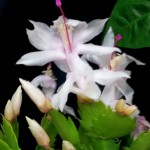If you are looking for an easy to grow, colorful indoor flowering plant, look no further than Holiday Cactus. The two main types are Thanksgiving Cactus and Christmas Cactus which have similar care requirements but as the name indicates, bloom at different times.
When purchasing a new plant, don’t assume that it is “Thanksgiving” or “Christmas” based on when it was blooming at the store, growers know how to manipulate plants for flowering based on market demand. Instead look at the leaf shape and anther colors for positive identification. Thanksgiving cacti have pointed teeth on leaf margins and yellow anthers in the flowers. Christmas cacti have flattened leaves with rounded teeth on the margins and purple anthers.
The best spot for your Holiday cactus is a bright location away from any drafts or heating and cooling vents. Keep soil slightly moist, but take care not to over water. They can tolerate some drying out, but too much can cause flower buds to drop. In Northwest Florida’s mild climate you may keep your Holiday Cactus outside most of the year, but protect it from full sun during the summer months and bring it indoors if temperatures are forecast to fall below 50° F.
Fertilize Holiday cacti with a general purpose houseplant fertilizer from April until August following label directions. To make your plants fuller, prune or pinch in June and this will encourage more branching. Holiday cacti are easy to propagate. Take those pieces you pinched off and place in a lightweight potting soil or vermiculite and they will grow roots and you will have new plants to share.
So, how do you control flowering time? Holiday cacti form flower buds based on two environmental factors, photoperiod (length of daylight) and temperature. They are considered “short day” plants which mean that they bloom when light is reduced to 8-10 hours a day, but this description can be a little misleading. The true influencing factor is not the number of daylight hours, but rather the number of hours in uninterrupted darkness. One way to initiate flower bud development is to place the plant in a dark closet from 5 p.m. until 8 a.m. for 20-25 days straight. This treatment will stimulate flower bud development. Another factor that influences flower bud initiation (even without light control) is the temperature at night. The ideal night temperature for flower bud formation is between 55 and 68° F. Temperatures above 68° and below 50° F can prevent flower bud development.
To learn more about caring for your Holiday Cactus visit the following link Thanksgiving & Christmas Cacti Clemson Cooperative Extension HGIC1554.
- Thinking of Starting a Cut Flower Business? Don’t miss out on Cut Flower 101! - October 30, 2025
- 2025 Gardening in the Panhandle LIVE! Great Southeast Pollinator Census – Bee a Citizen Scientist! Wrap Up - September 18, 2025
- Will you Bee a Citizen Scientist? - August 15, 2025

